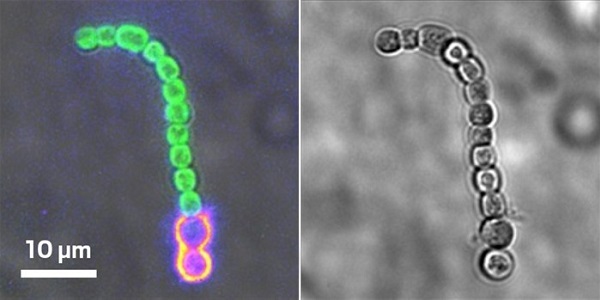Researchers have coaxed photosynthetic bacteria to ingest carbon nanotubes by wrapping the nanotubes in proteins (Nature Nanotechnology). This finding could lead to a new class of biological sensors and photovoltaic devices and also allow detailed study of bacterial cell mechanisms, the study’s authors say.
Bacteria have previously been shown to take up other nanomaterials like gold nanoparticles and glowing quantum dots. But scientists would like to use carbon nanotubes because they emit stable fluorescent light at near-infrared (NIR) wavelengths that do not overlap with the wavelengths that bacteria and other cells naturally emit. Nanotubes inside cells could be clearly detected for a long time, which would be useful for imaging and sensing.
Scientists have used nanotubes in mammalian cells for drug delivery and NIR imaging of cell metabolism. But while mammalian cells can actively swallow nanotubes, bacterial cell membranes are more complex and don’t allow nanotubes to pass through.

Cyanobacteria cells that have ingested nanotubes give off near-infrared light (glowing red cells shown left). Cells without nanotubes fluoresce green.
To get around this, Ardemis Boghossian, a chemical engineer at the Swiss Federal Institute of Technology, Lausanne (EPFL), and colleagues tried several protein- and peptide-based coatings that changed the surface charge of the nanotubes. “Bacterial outer membrane is negatively charged,” she says. “When wrapped with something that’s positively charged, [the nanotubes] were able to get inside the cells.”
The team inserted the coated nanotubes into cyanobacteria, which produce energy via photosynthesis. The researchers found that the nanotubes acted like a conductive wire, shuttling charge produced from inside the bacteria to the outside. Colonies of nanotube-containing bacteria produced 15 times as much current as those without nanotubes. As nanotube concentration increased, the amount of current increased, but only up to a limit. At too high a concentration, the nanotubes tended to kill the bacteria.
To the researchers’ surprise, the bacteria also pass the nanotubes on to their progeny. When the bacteria divide, the offspring inherit nanotubes along with part of the parent’s cell membrane. “This inherited nanobionics is a big novelty,” Boghossian says. “It’s as if you have someone with a bionic eye or arm and have their children inherit it.” The researchers could use the NIR fluorescence of the nanotubes to image the bacteria as they divide. “The nanotubes could also be used as optical sensors to monitor the bacteria’s metabolism,” Boghossian adds.
“Carbon nanotubes are a magnificent tool in optoelectronics,” says Massimo Trotta, a chemist at the National Research Council of Italy. This work demonstrates that bacterial cells can take up nanotubes without jeopardizing their growth and division, he says. Trotta hopes the idea can be taken further to develop new types of bacterial biosensors and biophotovoltaics that have “a lower carbon footprint and a smaller environmental impact.”
Read the original article on American Chemical Society (ACS).







